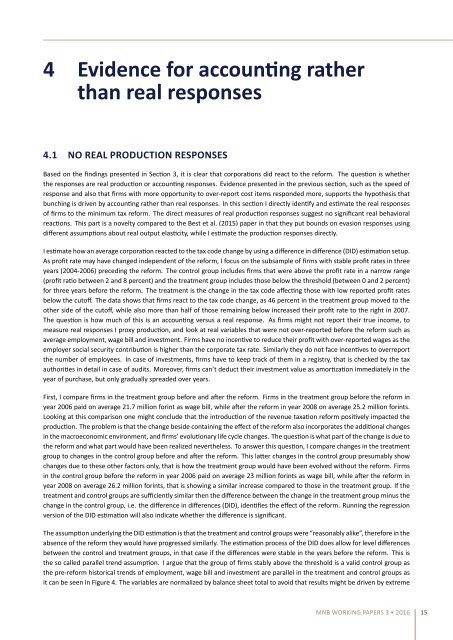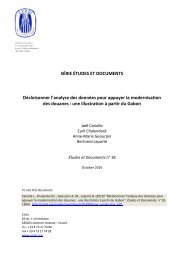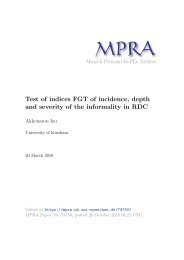Create successful ePaper yourself
Turn your PDF publications into a flip-book with our unique Google optimized e-Paper software.
4 Evidence for accounng rather<br />
than real responses<br />
4.1 NO REAL PRODUCTION RESPONSES<br />
Based on the findings presented in Secon 3, it is clear that corporaons did react to the reform. The queson is whether<br />
the responses are real producon or accounng responses. Evidence presented in the previous secon, such as the speed of<br />
response and also that firms with more opportunity to over-report cost items responded more, supports the hypothesis that<br />
<strong>bunching</strong> is driven by accounng rather than real responses. In this secon I directly idenfy and esmate the real responses<br />
of firms to the minimum tax reform. The direct measures of real producon responses suggest no significant real behavioral<br />
reacons. This part is a novelty compared to the Best et al. (2015) paper in that they put bounds on evasion responses using<br />
different assumpons about real output elascity, while I esmate the producon responses directly.<br />
I esmate how an average corporaon reacted to the tax code change by using a difference in difference (DID) esmaon setup.<br />
As profit rate may have changed independent of the reform, I focus on the subsample of firms with stable profit rates in three<br />
years (2004-2006) preceding the reform. The control group includes firms that were above the profit rate in a narrow range<br />
(profit rao between 2 and 8 percent) and the treatment group includes those below the threshold (between 0 and 2 percent)<br />
for three years before the reform. The treatment is the change in the tax code affecng those with low reported profit rates<br />
below the cutoff. The data shows that firms react to the tax code change, as 46 percent in the treatment group moved to the<br />
other side of the cutoff, while also more than half of those remaining below increased their profit rate to the right in 2007.<br />
The queson is how much of this is an accounng versus a real response. As firms might not report their true income, to<br />
measure real responses I proxy producon, and look at real variables that were not over-reported before the reform such as<br />
average employment, wage bill and investment. Firms have no incenve to reduce their profit with over-reported wages as the<br />
employer social security contribuon is higher than the corporate tax rate. Similarly they do not face incenves to overreport<br />
the number of employees. In case of investments, firms have to keep track of them in a registry, that is checked by the tax<br />
authories in detail in case of audits. Moreover, firms can’t deduct their investment value as amorzaon immediately in the<br />
year of purchase, but only gradually spreaded over years.<br />
First, I compare firms in the treatment group before and aer the reform. Firms in the treatment group before the reform in<br />
year 2006 paid on average 21.7 million forint as wage bill, while aer the reform in year 2008 on average 25.2 million forints.<br />
Looking at this comparison one might conclude that the introducon of the revenue taxaon reform posively impacted the<br />
producon. The problem is that the change beside containing the effect of the reform also incorporates the addional changes<br />
in the macroeconomic environment, and firms’ evoluonary life cycle changes. The queson is what part of the change is due to<br />
the reform and what part would have been realized nevertheless. To answer this queson, I compare changes in the treatment<br />
group to changes in the control group before and aer the reform. This laer changes in the control group presumably show<br />
changes due to these other factors only, that is how the treatment group would have been evolved without the reform. Firms<br />
in the control group before the reform in year 2006 paid on average 23 million forints as wage bill, while aer the reform in<br />
year 2008 on average 26.2 million forints, that is showing a similar increase compared to those in the treatment group. If the<br />
treatment and control groups are sufficiently similar then the difference between the change in the treatment group minus the<br />
change in the control group, i.e. the difference in differences (DID), idenfies the effect of the reform. Running the regression<br />
version of the DID esmaon will also indicate whether the difference is significant.<br />
The assumpon underlying the DID esmaon is that the treatment and control groups were “reasonably alike”, therefore in the<br />
absence of the reform they would have progressed similarly. The esmaon process of the DID does allow for level differences<br />
between the control and treatment groups, in that case if the differences were stable in the years before the reform. This is<br />
the so called parallel trend assumpon. I argue that the group of firms stably above the threshold is a valid control group as<br />
the pre-reform historical trends of employment, wage bill and investment are parallel in the treatment and control groups as<br />
it can be seen in Figure 4. The variables are normalized by balance sheet total to avoid that results might be driven by extreme<br />
MNB WORKING PAPERS 3 • 2016 15





